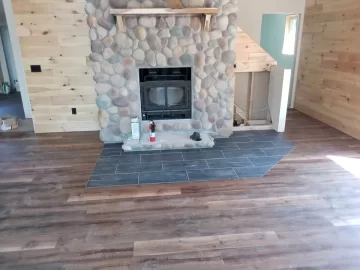Background:
I'm doing new construction and evaluating high-efficiency fireplaces. Spouse won't sign off on freestanding stove. I have fully insulated chase where exterior walls of the chase are insulated to the same specs as the exterior walls of the rest of the home. The home is ~4500sqft split between first and second floor with very open floorplan first floor, 9 ft first floor and 8ft second floor ceilings. The fireplace will be supplemental to multi-zone, ducted heat pump I can use to turnover the air. I don't plan on tying the fireplace to any heat distribution beyond they query here which is gravity kit to the same room for purposes of increased convection.
The question:
I really hate blower noise so looking at models with gravity kits hoping they will aid in convection, but there is very little information on gravity kits to the same room for the purposes of convection. There is also little information on operating without a blower (or without a blower and only gravity kits). Further, with an insulated chase, you can add chase venting near the floor and ceiling that will aid in convection...... but I'm not sure if this is better, worse, or could maybe even be done simultaneously with a gravity kit. Most fireplaces supporting gravity kits support two vents off the fireplace top that can be vented to the same room off the chase near the ceiling. I would probably vent them to the left/right "sides" of a hearth that pushes into the room so they are not visible head-on.
Some models seem to indicate the intake air for the gravity vents is from the chase itself and either venting of chase is required near the floor or an additional gravity intake is required near the floor. Other models imply the intake air for the gravity is just from the front louvers.
Who actually has gravity kits in use and on what models? How do they work for you? Do you use them with or without the stove blower and do they really aid in convection or not?
Fireplaces and the obligatory "request for reccomendation"
If it matters, my short-list of fireplaces includes:
I'm doing new construction and evaluating high-efficiency fireplaces. Spouse won't sign off on freestanding stove. I have fully insulated chase where exterior walls of the chase are insulated to the same specs as the exterior walls of the rest of the home. The home is ~4500sqft split between first and second floor with very open floorplan first floor, 9 ft first floor and 8ft second floor ceilings. The fireplace will be supplemental to multi-zone, ducted heat pump I can use to turnover the air. I don't plan on tying the fireplace to any heat distribution beyond they query here which is gravity kit to the same room for purposes of increased convection.
The question:
I really hate blower noise so looking at models with gravity kits hoping they will aid in convection, but there is very little information on gravity kits to the same room for the purposes of convection. There is also little information on operating without a blower (or without a blower and only gravity kits). Further, with an insulated chase, you can add chase venting near the floor and ceiling that will aid in convection...... but I'm not sure if this is better, worse, or could maybe even be done simultaneously with a gravity kit. Most fireplaces supporting gravity kits support two vents off the fireplace top that can be vented to the same room off the chase near the ceiling. I would probably vent them to the left/right "sides" of a hearth that pushes into the room so they are not visible head-on.
Some models seem to indicate the intake air for the gravity vents is from the chase itself and either venting of chase is required near the floor or an additional gravity intake is required near the floor. Other models imply the intake air for the gravity is just from the front louvers.
Who actually has gravity kits in use and on what models? How do they work for you? Do you use them with or without the stove blower and do they really aid in convection or not?
Fireplaces and the obligatory "request for reccomendation"
If it matters, my short-list of fireplaces includes:
- PacificEnergy FP30-arch: Established history and knowledge base. Not sure if no-cat is a plus or not.
- Astria Montecito Estate aka Superior WCT6940: New construction doesn't qualify for the tax credit.
- Osburn Stratford II aka Valcourt FP10: not sure...
- RSF Opal 2/3: My wife hates the look in marketing/brochures, the spec looks decent
- FPX44 or Napolean NZ6000: Seem dated by comparison. Both support a positive pressure type system that seemed to never take off and I don't see it on newer models either; does that mean it had problems? Aircooled stacks.....cheaper and I have insulated chase that should theoretically combat their weakness of poor draw in cold weather.....is this a pro I should be leveraging or still a con?
- Supreme Astra 38: A bit smaller than others on the list, but their product manual is the best by far in my opinion. Not sure if that translates to a better stove or not.
- And probably every other one in this class.....I've been reading manuals for weeks.


